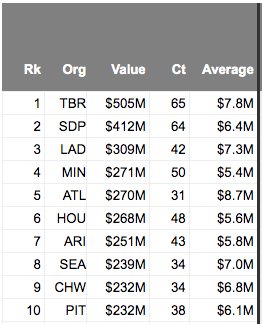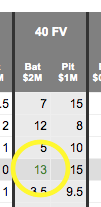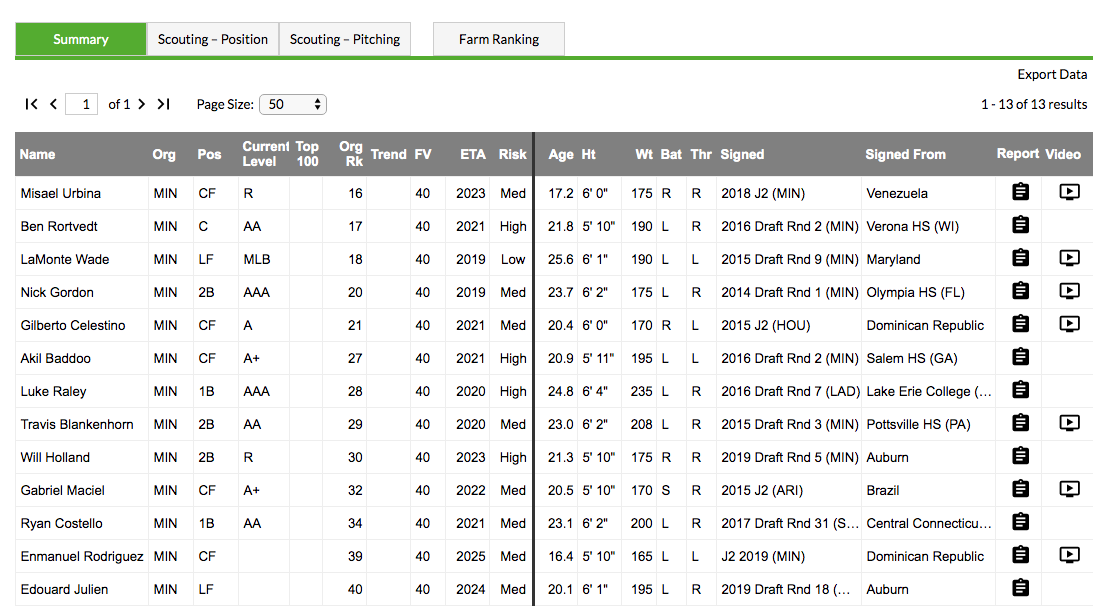Top 41 Prospects: Miami Marlins
Below is an analysis of the prospects in the farm system of the Miami Marlins. Scouting reports are compiled with information provided by industry sources as well as from our own (both Eric Longenhagen’s and Kiley McDaniel’s) observations. For more information on the 20-80 scouting scale by which all of our prospect content is governed you can click here. For further explanation of the merits and drawbacks of Future Value, read this.
All of the numbered prospects here also appear on The Board, a new feature at the site that offers sortable scouting information for every organization. That can be found here.
Editor’s Note: Diowill Burgos was added to this list following his acquisition from the St. Louis Cardinals for Austin Dean. Angeudis Santos was added after his acquisition from the Boston Red Sox for Austin Brice.
| Rk | Name | Age | Highest Level | Position | ETA | FV |
|---|---|---|---|---|---|---|
| 1 | Jazz Chisholm | 22.0 | AA | SS | 2022 | 55 |
| 2 | Sixto Sanchez | 21.5 | AA | RHP | 2020 | 50 |
| 3 | JJ Bleday | 22.2 | A+ | RF | 2021 | 50 |
| 4 | Edward Cabrera | 21.8 | AA | RHP | 2020 | 50 |
| 5 | Jesus Sanchez | 22.3 | AAA | RF | 2020 | 50 |
| 6 | Monte Harrison | 24.4 | AAA | CF | 2020 | 50 |
| 7 | Lewin Diaz | 23.2 | AA | 1B | 2021 | 50 |
| 8 | Trevor Rogers | 22.2 | AA | LHP | 2021 | 45+ |
| 9 | Connor Scott | 20.3 | A+ | CF | 2022 | 45 |
| 10 | Braxton Garrett | 22.4 | AA | LHP | 2021 | 45 |
| 11 | Nick Neidert | 23.1 | AAA | RHP | 2020 | 45 |
| 12 | Kameron Misner | 22.0 | A | RF | 2022 | 45 |
| 13 | Jerar Encarnacion | 22.2 | A+ | RF | 2022 | 45 |
| 14 | Peyton Burdick | 22.9 | A | RF | 2022 | 45 |
| 15 | Nasim Nunez | 19.4 | A- | SS | 2023 | 45 |
| 16 | Jorge Guzman | 24.0 | AA | RHP | 2020 | 40+ |
| 17 | Osiris Johnson | 19.2 | A | 3B | 2023 | 40+ |
| 18 | Victor Mesa Jr. | 18.4 | R | CF | 2024 | 40+ |
| 19 | Diowill Burgos | 19.0 | R | RF | 2023 | 40+ |
| 20 | Breidy Encarnacion | 19.2 | R | RHP | 2023 | 40 |
| 21 | Alex Vesia | 23.8 | AA | LHP | 2020 | 40 |
| 22 | Jordan Holloway | 23.6 | A+ | RHP | 2020 | 40 |
| 23 | Will Banfield | 20.2 | A | C | 2023 | 40 |
| 24 | Josh Roberson | 23.7 | A | RHP | 2021 | 40 |
| 25 | Evan Fitterer | 19.6 | R | RHP | 2024 | 40 |
| 26 | Jose Salas | 16.7 | R | SS | 2025 | 40 |
| 27 | Jose Devers | 20.1 | A+ | 2B | 2022 | 40 |
| 28 | Robert Dugger | 24.5 | MLB | RHP | 2020 | 40 |
| 29 | Chris Mokma | 18.9 | R | RHP | 2023 | 40 |
| 30 | Sterling Sharp | 24.6 | AA | RHP | 2020 | 40 |
| 31 | Brian Miller | 24.4 | AA | CF | 2020 | 40 |
| 32 | Victor Victor Mesa | 23.5 | AA | CF | 2020 | 40 |
| 33 | Ian Lewis | 16.9 | R | 2B | 2025 | 35+ |
| 34 | Will Stewart | 22.5 | A+ | LHP | 2021 | 35+ |
| 35 | Humberto Mejia | 22.9 | A+ | RHP | 2020 | 35+ |
| 36 | Cristhian Rodriguez | 18.1 | R | 3B | 2024 | 35+ |
| 37 | Dalvy Rosario | 19.5 | A- | SS | 2023 | 35+ |
| 38 | Thomas Jones | 22.1 | A | CF | 2022 | 35+ |
| 39 | Luis Palacios | 19.5 | R | LHP | 2023 | 35+ |
| 40 | Nick Fortes | 23.2 | A+ | C | 2021 | 35+ |
| 41 | Tristan Pompey | 22.8 | A+ | LF | 2021 | 35+ |
Other Prospects of Note
Grouped by type and listed in order of preference within each category.
Projectable Pitching
Eury Perez, RHP
Delvis Alegre, RHP
Mairo Doble, RHP
Maycold Leon, LHP
You can order these four in a lot of ways depending on your preference. Perez is 6-foot-5 and 155 pounds, and doesn’t turn 17 until early April. His fastball was way up last summer, touching 95 after he was just a projectable 83-86 when he was scouted. Alegre, 18, is the most polished of the bunch and arguably the most athletic. He has a four-pitch mix and is up to 95. Doble (up to 92) is more projectable but less athletic. Leon is 17 and only semi-projectable, but he’s a plus athlete with an overhand delivery that creates ride on his fastball (he currently sits in the upper-80s) and depth on his breaking ball.
Thumpers
Sean Reynolds, 1B
James Nelson, 3B
Joe Dunand, 3B
Lazaro Alonso, 1B
Evan Edwards, 1B
Lorenzo Hampton, RF
Reynolds is kinda freaky. He arguably has 80 raw and his average exit velos are near the top of the scale, but his levers are so long they need an intermission, and it’s unlikely he makes enough contact to get to first base-worthy power. Nelson is the most athletic of this group and has a body built for longevity but he hasn’t performed at all since his odd breakout, which we’re now several seasons removed from. Dunand is a strikeout-prone right/right corner infielder; Alonso has more playable power right now but is first base only. Edwards and Hampton are good-bodied 2019 draftees with big raw.
Possible 40-Man Arms
George Soriano, RHP
Julio Frias, LHP
Colton Hock, RHP
MD Johnson, RHP
Zach Wolf, RHP
Soriano hasn’t taken the step forward we hoped he would; he still has three average pitches and a frame that may portend more velocity. Frias is a low-slot lefty who touches 97 with a lot of running movement, but his command is very poor and it affects his secondary quality. Hock and Johnson touch the 94-96 range and live just beneath it with elite fastball spin. Both might be middle relievers. Zach Wolf has a data-friendly fastball because he’s 5-foot-8 and it comes in very flat. It might work in relief.
Post-Publication Acquisitions
Angeudis Santos, SS
Santos is a lanky, very projectable switch-hitting infielder with advanced ball/strike recognition. He’s an interesting developmental project.
System Overview
At a time when many teams are trending toward seeking concrete, measurable traits, shorter developmental timelines, and prospects who have lower outcome variance, the Marlins have targeted toolsy, high-risk prospects who might struggle because of unstable contact profiles, but otherwise have premium physical ability. This type of player runs through the farm system like a very wide river, which began flowing as soon as the current regime arrived and started the rebuild. Lewis Brinson, Sandy Alcantara, and Magneuris Sierra were the first round of high-profile names we saw acquired and they’re all still simmering, at best.
This type of prospect also pretty clearly runs through the hitters more frequently than the arms. Zac Gallen (later flipped), Nick Neidert, Jordan Yamamoto, and Robert Dugger don’t really fit this description.
While Miami has acquired this sort of player at an abnormal rate, they’ve also skimmed off the top of the Quad-A tier fairly well. Harold Ramirez has real raw power and a shot to make a swing change, Jon Berti is a versatile, 70 runner, and any of Garrett Cooper, Jesús Aguilar, or Jonathan Villar might end up tradable or on an ascendant Marlins team. You can see how, so long as some of these prospect really hit, at least some of supporting pieces are being conjured on the undercard.




